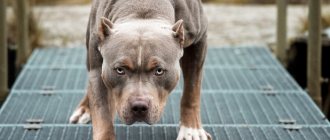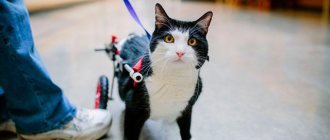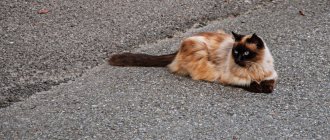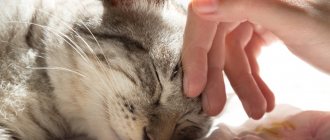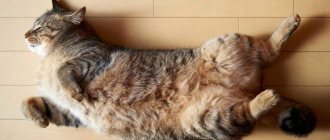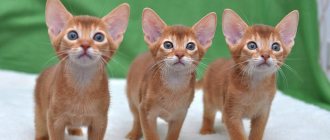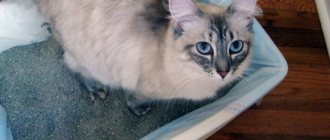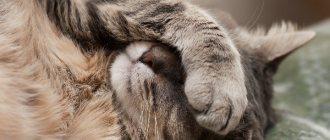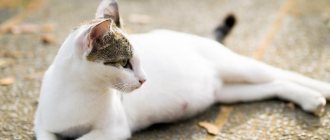However, almost all aspects of their behavior can be explained from a purely biological point of view. Alas, it’s still only “practically”. Still, a cat staring blankly at one point where there seems to be nothing is still a kind of mystery for zoologists. And Joinfo.ua will now tell you about a simpler aspect of cat behavior - why cats sometimes stand on their hind legs.
Inspection of the territory
Photo: Lockerdome
When a cat can climb something high, he does it.
When he can’t, in order to be aware of what’s happening around him, he has to stand on his hind legs. This somehow increases the field of view, especially if there is thick and tall grass around. The Joinfo.ua team and journalist Artem Kostin remind us that many animals do this in the wild, for example meerkats.
First aid at home
If the hind limbs fail, the cat should be seen by a doctor as soon as possible. First of all, you need to take the following measures:
- If the animal is panicking, it should be calmed down. You can talk to the cat in a gentle voice, stroke its head. It is important that the animal moves as little as possible.
- If trauma has led to paralysis, the cat must be fixed in one position. This should be done carefully so that the cat does not get nervous and try to escape. There should be a hard, hard surface underneath the animal. All movements should be kept to a minimum.
- If your limbs start to get cold, you can put a heating pad under them. It should not be very hot to avoid burns.
- If the animal is vomiting severely, the cat should be placed on its side so that the vomit does not clog the airways.
- If the cat has definitely not been injured, it can be placed on a soft surface (put a blanket in the carrier).
You need to take your animal’s veterinary passport with you to the clinic. Disposable diapers and clean napkins will not hurt. If it is cold outside, the animal should be covered.
Diagnostics
There can be many reasons for hind leg failure in cats. If the owner himself has not witnessed the injury that the cat received, a large-scale diagnosis will have to be carried out.
At the clinic, the veterinarian will conduct the following tests:
- Take a general urine and blood test. They can be used to determine the presence of inflammatory processes in the body.
- Conducts an external inspection. Test the sensitivity of the limbs and reflexes.
- Take an x-ray of the spine. It shows the presence of fractures, tumors, and dislocations.
- It is possible to take an x-ray using contrast fluid.
- If an infection is suspected, the doctor may take a bacterial culture.
- If damage to internal organs is suspected, the doctor will perform an ultrasound.
- If necessary, an MRI of the brain and spine can be done.
You might be interested in: What causes cat hair loss?
Injuries or impairments
Photo: Hronika
It also happens that cats prefer not to put weight on their front paws solely because it is painful. Fractures, deformations, arthritis of the front legs, and other congenital and acquired anomalies - all this leads to the fact that the animal has to learn the least traumatic gait - on the hind legs. And in the case of traumatic amputation or congenital absence of limbs, in principle there is no alternative to such a gait.
We also think you might be interested to know why cats love to sleep on their owners. There are plenty of reasons for this too.
Causes of hind limb failure
Neurological disorders often lead to failure of a cat's hind legs. In most cases, only a doctor can determine the exact cause of paralysis.
Let's list a number of diseases that can lead to failure of a cat's hind limbs.
Injuries
Although cats are considered graceful creatures, they often fall from roofs or trees. An unsuccessful landing can lead to spinal injury or broken paws. Cats also sometimes get hit by cars. A dog bite or a directed blow can cause mechanical damage to the limbs and spine.
An injured animal may be in a state of shock, so immediately after the incident it will try to hide. When a limb is broken, the animal may feel severe pain when leaning on the limb. The paws may be unnaturally curved. The cat may have a dislocation, open or closed by a redissection.
Thromboembolism
This is a very dangerous disease that can lead to the death of the animal. This is when a cat's femoral artery is blocked by a blood clot (this could be a blood clot, a parasite, or air).
As a result, the limbs are deprived of oxygen supply. Tissue necrosis begins. The animal's condition is rapidly deteriorating.
In the first hours, the following symptoms can be observed:
- anxiety;
- meowing in pain;
- the animal does not allow you to touch the sore area (scratches, bites).
Gradually, the paws completely fail, they become cold. Apathy begins. The cat doesn't eat or drink. Death usually occurs within 2-3 days. You can save an animal if you consult a doctor in the first hours after an artery is blocked by a blood clot.
Dysplasia
This disease most often occurs in large cats (Maine Coons), but smaller breeds are also genetically predisposed to it: Siamese, Persian, Norwegian forest cat, British, Scottish.
You might be interested in: The cat has a broken fang: how to help the animal?
In most cases, this disease is congenital. It becomes most noticeable during the period of active growth of the kitten. With dysplasia, excessive formation of connective tissue occurs, the joint becomes too mobile. The animal experiences pain while moving.
Main symptoms:
- unsure gait;
- decreased activity;
- when resting, the cat stretches its paws rather than tucking them under itself;
- when walking, the animal experiences pain, and therefore tries not to strain its limbs too much;
- after the jump, the cat falls on its side and meows pitifully.
This disease is incurable. Maintenance therapy should be carried out - anti-inflammatory and painkillers should be given. Obesity should not be allowed in a sick animal, because it increases the load on sore joints.
Kidney failure
A dangerous disease that can appear in cats of all ages. It leads to disruption of the genitourinary system, as well as to a neurophysiological disorder. The functioning of the brain is disrupted.
Main symptoms:
- gradual decrease in the amount of urine;
- indigestion;
- unsteady gait, limb failure;
- increase in body temperature.
Avitaminosis
A poor diet, infection with parasites, and improper care lead to vitamin deficiency. An insufficient amount of vitamins and minerals enters the animal’s body, which causes a disruption in the development of bone and cartilage tissue.
If the animal does not receive enough sunlight, this can lead to rickets, which is often found in kittens. When it occurs, the development of bone tissue is disrupted, the limbs become bent and become fragile.
Lack of potassium leads to paresis of the limbs.
To avoid vitamin deficiency, the animal needs to be provided with a proper, complete diet. A cat that eats natural food should additionally receive vitamins.
Among ready-made food, preference should be given to premium and super-premium class. Economy class food does not contain enough minerals and vitamins.
Cardiomyopathy
Cardiomyopathy leads to an increase in the volume of the walls of the heart muscle, due to which the volume of the ventricles decreases. The heart pumps less blood. Oxygen starvation begins. The animal's limbs go numb.
Main symptoms:
- decreased activity;
- unsteady gait;
- refusal to eat;
- vomit.
Cardiomyopathy itself cannot lead to complete paralysis of the hind limbs. But because of it, thrombosis of the femoral artery can occur.
Stroke
There is a blockage of one of the blood vessels in the brain. A stroke can lead to paralysis of not only the limbs, but also all muscles. The animal may be completely immobilized.
Main symptoms:
- breathing and swallowing problems;
- severe anxiety;
- complete apathy;
- loss of sensation in the limbs;
- vomit.
Stroke is a very dangerous disease that can often lead to the death of an animal. A sick cat needs urgent medical attention. The sooner the correct diagnosis is made and measures are taken, the greater the chance of survival and recovery of the animal.
Spinal injury
The spine may be damaged due to injury or internal pathological processes.
The main sign of spinal injury is paralysis of not only the paws, but also the tail.
The animal begins to walk under itself. The sensitivity of the limbs is completely lost.
When a spinal fracture occurs, the following symptoms may occur:
- the cat's tail hung
- rapid breathing;
- loss of consciousness;
- strong heartbeat;
- decrease in body temperature.
Intervertebral hernia
A hernia forms on an intervertebral disc. An experienced doctor can detect it by palpation. The nerves are compressed, causing the animal to be unable to move its limbs normally.
You might be interested in: Why does a cat constantly tuck its tail between its legs?
Most often, a hernia occurs in older animals. In most cases, it does not lead to complete failure of the limbs, but only to a disturbance in gait. The situation can only be corrected by surgical intervention.
Tick paralysis
The bite of ixodid ticks leads to the entry of toxic substances into the body. The disease develops very quickly.
At first, the cat begins to behave very excitedly. Afterwards, activity decreases and limbs fail. The cat stops eating and drinking and reacts poorly to stimuli. Body temperature rises greatly. Severe trembling and vomiting are possible. The animal loses consciousness and convulsions begin.
The cat can be saved only if treatment is started in time. In half of the cases when bitten by an infected tick, the animal dies.
Spinal cord inflammation
It can occur for various reasons: infection by parasites, poisoning, infection and others.
Main symptoms:
- increased body temperature;
- indigestion;
- urinary incontinence.
With timely consultation with a doctor, complete restoration of limb function is possible.
Hyperparathyroidism
Most often, hyperparathyroidism is caused by improper and unbalanced feeding of the animal. The production of hormones is disrupted. Calcium from the animal's bones enters the blood. The bones themselves become thinner and more fragile. The animal's gait is disturbed, the cat feels severe pain. The spine also becomes more fragile. Neurological functions are impaired, causing the cat's hind legs to fail.
Nerve damage during injection
Sometimes when administering an intramuscular injection, the owner or doctor may hit the sciatic nerve with a needle. This can lead to temporary impairment of the animal's paw. Often the limb returns to normal within a few days.
My cat fights with her hind legs. What does it mean?
Contents hide
We continue to examine numerous cat oddities - cute and not so cute. Today we will try to explain one very interesting behavior model. Situation: You are playing with your furry pet or just reaching out to pet him. But your actions are not assessed quite adequately: the cat quickly rolls over onto its back and begins to vigorously fight back with its hind legs, inflicting blows and deep and painful scratches. Most often this happens in the midst of joint games and affection.
Dr. Wailani Sung answers - she is known to our readers for her unconventional view on many everyday things.
The behavior is interesting and not typical for all cats. There may be several explanations.
For example, a regular fighting game. Both the owner and his pet understand that there is a very ordinary struggle going on, and no one wants to give in. But each side has its own spare “tricks” that can be used for a quick victory.
It is also quite common for cats to use their hind legs when using so-called defensive tactics, that is, actively defending themselves. Most likely, the domestic cat understands perfectly well that there is no real danger from the owner. Therefore, the hind legs launched in the heat of the game can be roughly translated as “leave me alone” or “I’m tired of it.”
In the wild, everything works differently. Cats, being small animals, are attacked quite often. In the event of a sudden attack, they prefer to roll over onto their backs and defend themselves in this position, using all four paws. The cat tries to grab the enemy with its front paws (which is quite natural) and at the same time strikes with its hind paws - in the underbelly or other sensitive place. Admittedly, this is the right tactic: confident of an easy victory, the predator is so carried away by the attack that it reveals all its weak points. Which, in fact, is what resourceful cats take advantage of - it’s not for nothing that they say that they have nine lives. In addition, let's not forget about the powerful cat's claws, which are capable of causing serious injuries to the adversary. By the way, the defensive tactics of the mustachioed striped ones are simple: quickly deliver a sensitive retaliatory strike, thereby discouraging the enemy. A certain amount of time appears to either force him to retreat or escape.
As for the “kick” with the hind paws during petting and playing, this behavior can be regarded in two ways: both as an invitation to further active play and as a warning signal. When the opportunity arises, be sure to watch the little kittens play in the box. Babies often roll over onto their backs and push with their hind legs without causing injury to each other. Which, in principle, cannot be said about the hands of the owner. They have no protective fur, and cat claws, whatever one may say, are a formidable weapon.
However, the best thing to do when you feel a blow from your hind legs is to stop playing and stand up. If this is not done, then the naughty pet will most likely grab your hand with its front paws and begin to hold it, while simultaneously scraping with its hind paws. This is the kind of bind you can accidentally get into.
And one more practical piece of advice. As noted above, when preparing to use its hind legs, your pet will typically roll over onto its back. Don't give in to temptation, don't start touching and stroking his tummy. Firstly, this is fraught with deep scratches and grass. Secondly, cats usually show their tummy to those they trust. And at the same time, they do not want anyone to touch such a sensitive place. Don't abuse your furry friend's trust.
Original Post: Why Does My Cat... Kick Her Back Legs? Author : Dr. Wailani Sung. Source : vetstreet.com Photo: pixabay.com
Diseases of the joints and bones
Joint and bone diseases appear in cats, as a rule, at 7-8 years of age - these are the first signs of aging. However, young individuals often develop ailments, many of which are transmitted genetically. Common diseases of the joints and bones of felines include arthrosis and arthritis, osteochondrosis, traumatic arthrosis, osteomyelitis, etc.
Arthrosis
Arthrosis is a non-inflammatory chronic disease. It is asymptomatic for a long time - degenerative reformations in soft tissues, bones and cartilage develop gradually. One of the common causes is a congenital defect of the anatomical structure of the animal. Mostly adults are affected, but sometimes the disease also affects young pets.
Be sure to read:
The cat is drooling from the mouth: physiological and pathological causes, when to treat
Traumatic arthrosis
Traumatic arthrosis is caused by injuries received in youth. Bruises and dislocations that go unnoticed by the owner with age lead to incorrect alignment of bones, cartilage and soft tissues. Often the cause is damage to the lumbar region. This usually happens when landing incorrectly from a height, being hit on the back with a stick, or fighting with dogs. Pinched nerve endings at such a moment lead to severe lameness and discomfort.
Treatment methods
The choice of treatment method directly depends on the cause that led to the failure of the hind legs. To successfully rid a cat of this disease, owners must strictly follow the instructions of the attending physician.
Treatment methods for a cat that has lost its hind legs:
- Surgical intervention. Typically, surgery is performed on cats in the most extreme cases, when full recovery is impossible without it: for herniated intervertebral discs, spinal injuries, or, for example, severe dysplasia. If a cat is diagnosed with cancer, she is also prescribed drug and radiation therapy.
- Diet. The cat may need to be put on a special diet and provided with food that is rich in calcium, phosphorus and other nutrients.
- Drug therapy. Depending on what disease your cat has been diagnosed with, different medications may be prescribed. For example, antibiotics, antispasmodics, painkillers, anti-inflammatory drugs, anticoagulants, chondroprotectors.
- Creating a special environment in the house for the cat. For some diseases, for example, inflammation of the spinal cord, the cat must be placed in a dark, quiet place, protected from stress. In combination with drug therapy and physiotherapy, such an environment will contribute to a rapid recovery.
- Plaster application. In case of fractures, serious bruises, or to eliminate the consequences of dysplasia, a cast can be applied to the cat, which will fix the limb in the correct position and speed up the process of its recovery.
- Physiotherapy.
Physiotherapy procedures that a doctor may prescribe
The recovery period for a cat after failure of its hind legs can take a long time. To speed it up, doctors often prescribe daily physiotherapy for animals, which the owner can carry out together with the pet independently at home:
- Stimulating massage. It should be done for 10-15 minutes 5-7 times a day with intense but light movements. You should knead not only the paw pads, but also the limbs themselves. Massage helps restore the conduction of nerve impulses and protects muscles from atrophy.
- Using an inflatable ball. The cat must be placed with its stomach on a suitable-sized ball so that its paws lightly touch the floor. Then roll it back and forth, while carefully holding the pet. At the extreme points, it should seem to stand on its paws.
- Tickling paws. Helps the owner understand when sensitivity will return.
- Swimming. Gives excellent results if the cat is not afraid of water. It is necessary to fill the bathtub and hold the pet under the stomach so that it does not choke. In the water, the cat will instinctively begin to move its paws and try to swim.
- Physiotherapy. Gymnastics in the form of forced flexion and extension of the limbs, as well as exercises that resemble cycling, are very useful. This exercise must be done for at least 5 minutes a day.
- Walking simulation. You need to take the pet by the hind legs and slowly move them, imitating walking. To do this, you can use support in the form of a wide towel, which you need to pass under the cat's belly.
If the hind legs fail, cat owners should not despair. On the contrary, you need to take your pet to the veterinarian as soon as possible. Timely medical care, properly selected treatment and daily physiotherapeutic procedures in most cases allow cats to return to a full life over time.
